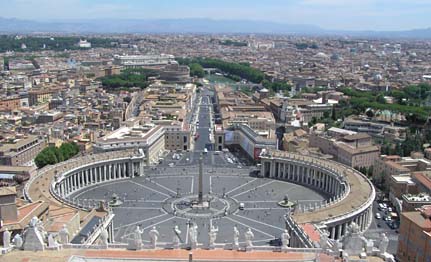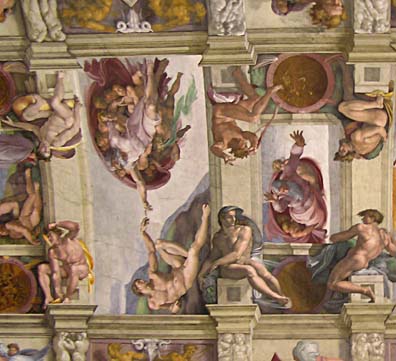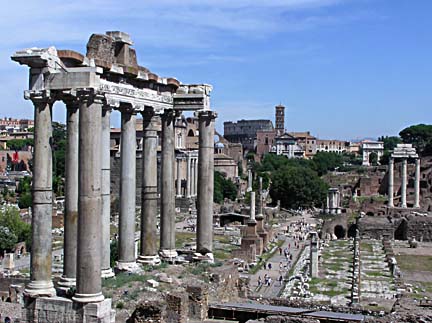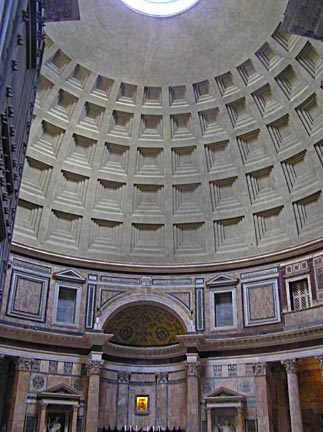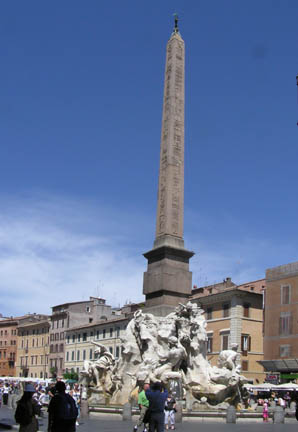|
We came to Rome in July, 2005. Jim had visited Rome once before in 1969 but Verna had never been there. So in a whirlwind of 2 (long)days we saw just about everything we came to see (and more). At right is the view of Rome from St. Peter’s.
|
We arrived on a Saturday so headed straight for the Vatican Museums as they close early on Saturday and are closed on Sunday. We met up with a few hundred other people also trying to do the same thing. Evidently many had been waiting in line for a while before opening time as we got in line just 10 minutes after opening and it took us an hour to get to the entrance. However, in the meantime, we did meet a group of youngsters from Australia on a youth tour and a young couple from Sacramento, California. So we had a pleasant time chatting to them and chasing away the beggars that tried to accost us.
|
|
|
|
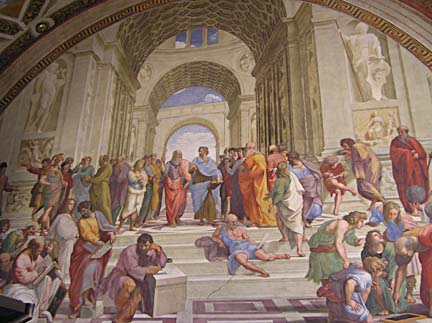
|
The museums are huge and in total cover an area of 5.5 hectares, so it behooves you to plan ahead and know what you want to see. Basically, the museums contain most of the items collected by the popes over the years. As a result, there are miles of statues, miles of tapestries, and rooms and rooms of art and treasures. We wanted to see the rooms painted by Rafael and of course the Sistine Chapel. So we skirted the most congested areas and passed through the many tour groups to get to our destinations. The Rafael room was indeed impressive with the walls frescoed in various themes. His painting “The School of Athens” showing the major philosophers is truly magnificent, as are the others in the room.
|
|
|
We then headed to the Sistine Chapel, the main reason most visitors are there. And it appeared that most of them were in the chapel! It was so crowded, it was difficult to move around and the heat and humidity from all those bodies made it quite unbearable for us to linger long. Verna snapped one photo of the famous ceiling (which everyone was doing) before the announcement came over the loudspeaker telling us not to take photos. As luck would have it, she got a good picture of the famous reach.
We were lucky to get out of there in about 45 minutes, enjoying all the other treasures along the way, but not stopping to read or peruse them in detail. If you wanted to see everything, it would take you weeks to get through it all.
On to St Peter’s Cathedral and the climb up the dome. Again, we got caught in the rush and waited in line for about an hour (if we were to do it again, we would have done St. Peter’s first, then the Vatican as the line decreased by the time we got out). Nevertheless, the climb (all 320 steps plus the elevator ride) was worth the wait and provided us with spectacular views of Rome (photo at top of page).
|
|
|
We then headed for the Forum which is a bit of a walk across town. The Forum was the center of Rome in ancient times, containing businesses, political centers and temples. You can get a great view of the Forum from Capitolino Hill. It covers quite an area and you are free to wander through most of it. There are a few majestic columns still standing, as well as the arches (photo above), and they give you an impression of what it must have been like (with a bit of imagination). You can also see portions of the Palatine from the Forum area. Just down the road from the Forum is the Colosseum (photo right) which is quite impressive as well. Ancient Rome must have been quite a place. There a few other forums in the area that are still being excavated, but are visible from the road. These Forums were almost completely covered when Mussolini built his grand thoroughfare through this area in 1933.
And no trip to Rome is complete without a visit to Trevi Fountain (thanks to the movie La Dolce Vita). No, we didn’t throw any coins in, but we were impressed by the size of the fountain as it totally overpowers the small piazza in which it is located. We couldn’t stand back far enough to get a picture of the entire fountain. This area was swarming with tourists and had quite a police presence as well, probably due to the high incidence of pick-pocketing.
Our main goals were met so we spent some time wandering through the streets, visiting other piazzas, fountains, and churches (did you know there are over 900 churches in Rome?). One of the impressive sites is the Pantheon, the best preserved building of ancient Rome. This temple was originally built in 27 BC, then rebuilt by Hadrian around 120 AD. The height and width of the interior is exactly the same (43.3 meters) and the dome is considered to be the most important achievement of ancient Roman architecture (as well as being the largest masonry vault ever built). The photo at left captures a portion of the dome and wall, as seen through the enormous entry doors. The light at the top is a hole in the top of the dome to allow light to enter. On the floor below are several small holes to allow rain water to drain away.
Also noteworthy was the Piazza del Popolo which was the main entrance to the north of the city in the early 16th century when the piazza was constructed. Above the piazza you can get a good view of the city. Piazza Navona is also a spectacular (but smaller) square, lined with Baroque palaces and a magnificent Bernini fountain in the center (Fountain of the 4 Rivers). There were several street vendors selling their wares in the square when we arrived, then all of a sudden, they all darted to the far end of the piazza. We knew the polizi had arrived even before glancing over our shoulder to verify.
All in all, a very worthwhile and interesting visit to Rome, even if it was a bit short. You could spend weeks there and still not see everything, so being selective is the most important thing.
Arrivederci Roma!
|

